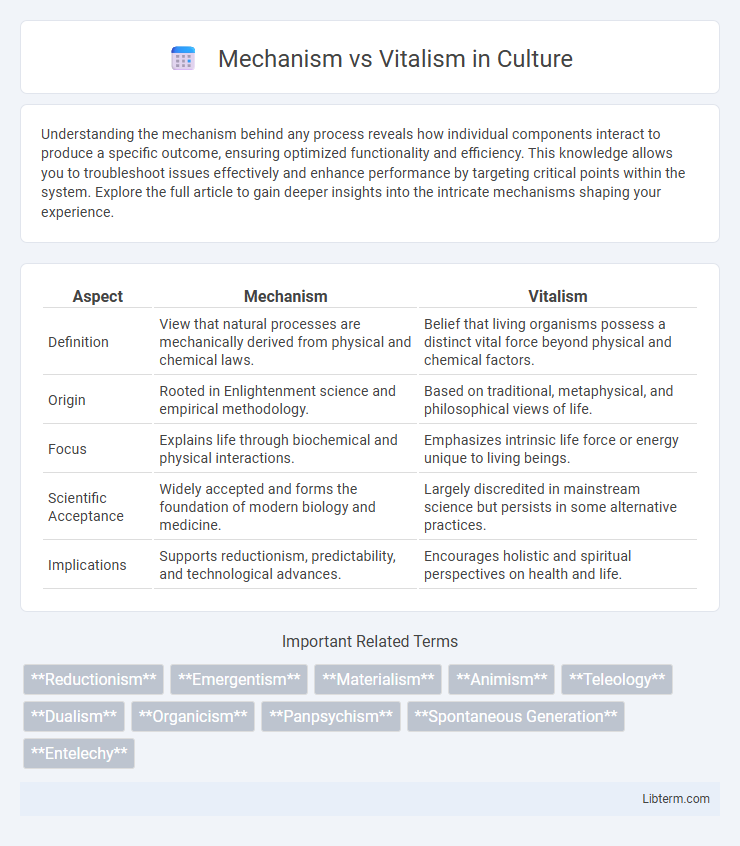Understanding the mechanism behind any process reveals how individual components interact to produce a specific outcome, ensuring optimized functionality and efficiency. This knowledge allows you to troubleshoot issues effectively and enhance performance by targeting critical points within the system. Explore the full article to gain deeper insights into the intricate mechanisms shaping your experience.
Table of Comparison
| Aspect | Mechanism | Vitalism |
|---|---|---|
| Definition | View that natural processes are mechanically derived from physical and chemical laws. | Belief that living organisms possess a distinct vital force beyond physical and chemical factors. |
| Origin | Rooted in Enlightenment science and empirical methodology. | Based on traditional, metaphysical, and philosophical views of life. |
| Focus | Explains life through biochemical and physical interactions. | Emphasizes intrinsic life force or energy unique to living beings. |
| Scientific Acceptance | Widely accepted and forms the foundation of modern biology and medicine. | Largely discredited in mainstream science but persists in some alternative practices. |
| Implications | Supports reductionism, predictability, and technological advances. | Encourages holistic and spiritual perspectives on health and life. |
Introduction to Mechanism and Vitalism
Mechanism explains biological processes through physical and chemical laws, emphasizing that living organisms function like complex machines governed by mechanical principles. Vitalism argues that life is driven by a unique vital force beyond physical and chemical explanations, asserting that this non-material essence is essential for biological functions. These contrasting views shape foundational debates in biology regarding whether life can be fully explained by scientific laws or requires the presence of a distinct life force.
Historical Background of Mechanism
Mechanism emerged in the 17th century as a scientific approach explaining natural phenomena through physical causes and mechanical laws, contrasting with the earlier animistic views. Pioneers like Rene Descartes and Galileo Galilei advanced the idea that living organisms function as complex machines governed by mathematical principles. This shift laid the foundation for modern biology by promoting empirical observation and rejecting supernatural explanations prevalent in vitalism.
The Origins and Development of Vitalism
Vitalism originated in the 17th century as a response to mechanistic explanations of life, proposing that living organisms possess a unique vital force beyond physical and chemical processes. Early proponents such as Georg Ernst Stahl and Hans Driesch emphasized this immaterial vital principle, arguing it controlled biological functions and development. The concept evolved through the 19th century but declined with advancements in biochemistry and molecular biology demonstrating life processes can be explained by physical and chemical laws.
Key Arguments of Mechanistic Theory
The mechanistic theory asserts that all natural processes, including biological functions, can be explained through physical and chemical laws without invoking any vital force or supernatural agency. It emphasizes cause-and-effect relationships, treating organisms as complex machines governed by the same principles as inanimate matter. This theory is supported by empirical evidence from physiology and biochemistry, which demonstrate that life functions arise from molecular and cellular interactions.
Core Principles of Vitalist Thought
Vitalist thought centers on the idea that living organisms possess a unique vital force or life energy that cannot be reduced to physical or chemical processes alone, distinguishing them from inanimate matter. This vital force is considered intrinsic and self-regulating, driving growth, development, and healing in ways mechanistic explanations cannot fully capture. Vitalism emphasizes the holistic and dynamic nature of life, asserting that physiological functions arise from this inherent principle beyond purely mechanical interactions.
Mechanism vs Vitalism: Major Differences
Mechanism explains biological processes through physical and chemical laws, emphasizing that all phenomena in living organisms can be understood by mechanical principles. Vitalism, in contrast, asserts the presence of a unique vital force or energy that distinguishes living beings from inanimate objects and cannot be reduced to physical explanations. The major difference lies in Mechanism's reliance on empirical, measurable causes versus Vitalism's assertion of an irreducible life force beyond scientific observation.
Influential Figures in the Debate
Rene Descartes championed Mechanism with his dualistic approach, arguing that the body functions like a machine governed by physical laws, while vitalists like Hans Driesch emphasized the existence of a non-material "life force" essential for biological processes. Claude Bernard contributed to Mechanism by advocating for empirical experimentation and the physical-chemical explanation of life phenomena. In contrast, Henri Bergson introduced the concept of elan vital, a creative life principle challenging purely mechanical views and influencing vitalist thought.
Criticisms and Controversies
Mechanism faces criticism for its reductionist approach, which some argue oversimplifies complex biological processes by likening living organisms to machines, neglecting the subjective experience and intrinsic purpose found in life. Vitalism, although emphasizing a distinct life force beyond physical and chemical laws, is often criticized for lacking empirical support and being unfalsifiable within scientific methodology. The controversy between mechanism and vitalism centers on the explanatory power and scientific validity, with debates persisting over whether life can be fully explained by physical laws or requires a non-material principle.
Modern Perspectives and Relevance
Modern perspectives on mechanism emphasize biochemical and physical processes as explanations for life functions, integrating advances in molecular biology and neuroscience to detail cellular and systemic activities. Vitalism, historically centered on a non-material "life force," has diminished in scientific credibility but remains relevant in holistic and alternative medicine frameworks, highlighting the complexity of biological organization beyond reductionist views. Contemporary research often bridges these perspectives by exploring emergent properties and systems biology, acknowledging both mechanistic processes and the dynamic, integrative nature of living organisms.
Conclusion: The Ongoing Impact
The ongoing impact of Mechanism versus Vitalism lies in shaping contemporary scientific and philosophical approaches to life and biology, where Mechanism underpins empirical and reductionist methods, while Vitalism influences holistic and integrative perspectives. Mechanism's legacy advances biomedical technologies and mechanistic explanations of physiological processes. Vitalism continues to inspire fields such as alternative medicine and complex systems theory, emphasizing the irreducible qualities of living organisms.
Mechanism Infographic

 libterm.com
libterm.com